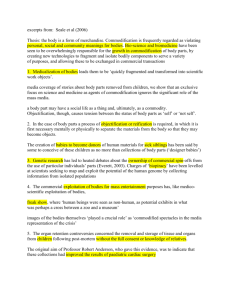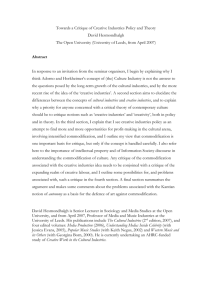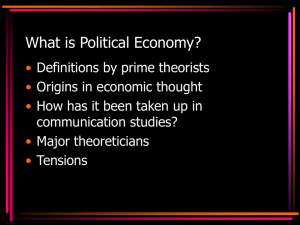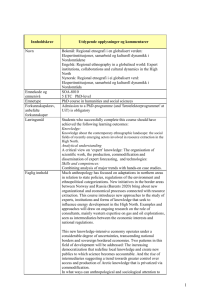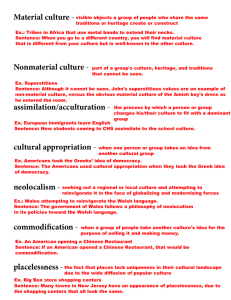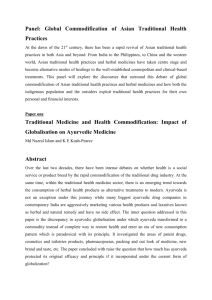Commodification and Consumer Society: A Bibliographic Review
advertisement
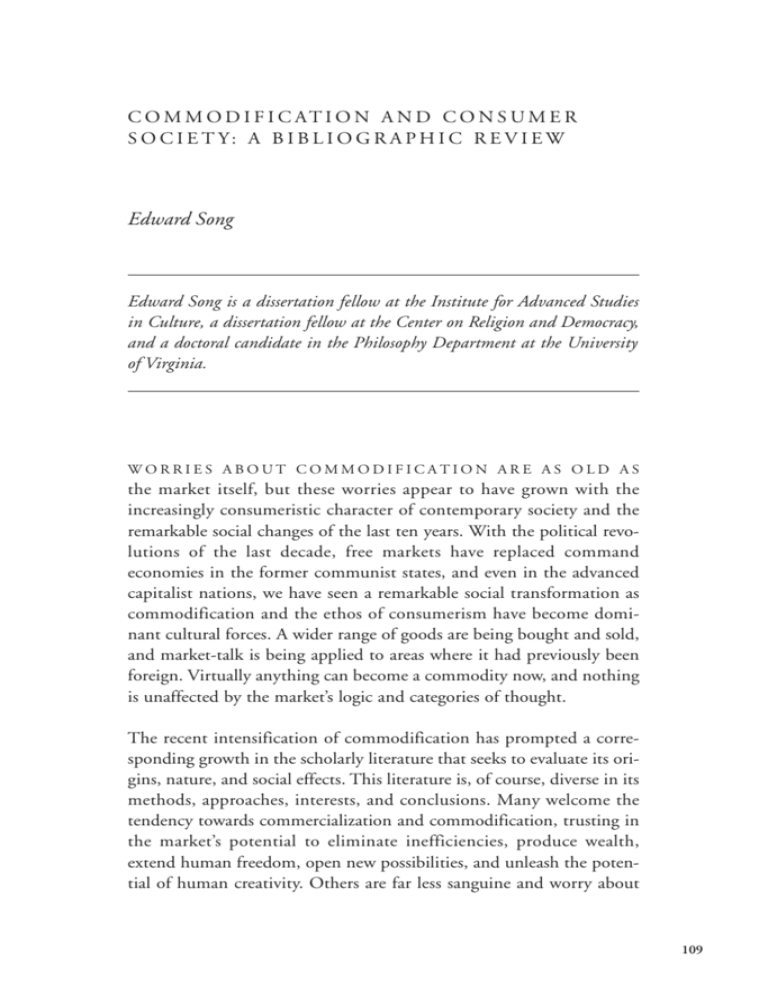
C O M M O D I F I C AT I O N A N D C O N S U M E R S O C I E T Y: A B I B L I O G R A P H I C R E V I E W Edward Song Edward Song is a dissertation fellow at the Institute for Advanced Studies in Culture, a dissertation fellow at the Center on Religion and Democracy, and a doctoral candidate in the Philosophy Department at the University of Virginia. WORRIES ABOUT COMMODIFICATION ARE AS OLD AS the market itself, but these worries appear to have grown with the increasingly consumeristic character of contemporary society and the remarkable social changes of the last ten years. With the political revolutions of the last decade, free markets have replaced command economies in the former communist states, and even in the advanced capitalist nations, we have seen a remarkable social transformation as commodification and the ethos of consumerism have become dominant cultural forces. A wider range of goods are being bought and sold, and market-talk is being applied to areas where it had previously been foreign. Virtually anything can become a commodity now, and nothing is unaffected by the market’s logic and categories of thought. The recent intensification of commodification has prompted a corresponding growth in the scholarly literature that seeks to evaluate its origins, nature, and social effects. This literature is, of course, diverse in its methods, approaches, interests, and conclusions. Many welcome the tendency towards commercialization and commodification, trusting in the market’s potential to eliminate inefficiencies, produce wealth, extend human freedom, open new possibilities, and unleash the potential of human creativity. Others are far less sanguine and worry about 109 THE HEDGEHOG REVIEW / SUMMER 03 the potentially corrosive effects of the market—its capacity to widen and exacerbate social and economic differences, corrupt various goods and social values, expose the disenfranchised to greater exploitation and manipulation, and encourage patterns of consumption that put pressure on vulnerable natural resources. This bibliography attempts to survey the vast literature on commodification by first looking at the classic and contemporary attempts to theorize the origin and structure of the phenomenon of commodification. It then turns to the historical development of commodification, first looking at the early origins of consumerism and its development through the important postwar period. Advertising and shopping are crucial engines to the growth of a commodified culture and a survey of this literature is followed by an examination of the literature that attempts to provide systematic theoretical tools to evaluate the ethical dimensions of the market and its expansion. Finally the bibliography ends with a survey of some of the most prominent recent celebrations and critiques of the phenomenon of commodification. Classic Studies of Commodification These classic studies of commodification are most notably characterized by an emphasis on the material circumstances of class and production as the key determinants of the cultural dynamics of commodification. This approach finds its roots in the writings of Karl Marx, who did not coin the term “commodification,” but whose analysis of commodities and alienation are lasting bedrocks of its study. Capitalism differs from other modes of production in that goods are not owned by those who produce them, and their value does not lie in their usefulness but in their exchange value. Operating under dehumanizing conditions, workers become alienated from the objects of their labor, their own true nature, and their fellow workers. Further, the commodities produced by capitalist production are fetishized, abstracted and detached from their real use in ways that create further confusion about their origins and value. 110 COMMODIFICATION AND CONSUMER SOCIETY/SONG This basic mode of analysis is extended by a variety of twentiethcentury neo-Marxists, most notably those associated with critical theory and the Frankfurt School. One of the central texts of this mode of analysis is Max Horkheimer and Theodor Adorno’s Dialectic of Enlightenment, which attempts nothing less than explaining “why humanity, instead of entering a truly human state, is sinking into a new kind of barbarism.”1 Tying this collapse to the self-destructive tendency of the Enlightenment’s understanding of rational calculability and technology, they presciently argue that this dynamic will ultimately produce a debased mass culture where the desires and fancies of passive consumers are easily manipulated by producers for their own ends. Two other prominent accounts of commodification that focus on the producers’ ability to manipulate consumers are John Kenneth Galbraith’s The Affluent Society and Betty Friedan’s The Feminine Mystique. Galbraith’s work highlights the ways that producers, through advertising and salesmanship, produce desires for the goods they manufacture. Similarly, Friedan focuses on how the ideal of the housewife was manipulated to create a stable and sizeable market of willing buyers. Max Weber attempted to amend Marx’s exclusive focus on material production by introducing the importance of social prestige or status in addition to wealth and ownership of the means of production. These factors play an important role in Thorstein Veblen’s analysis of consumption, which argues that consumption is driven by the desire to accrue prestige through conspicuous displays of leisure and consumption. Weber also highlights the ever increasing bureaucratization of society and the inexorable progression to ever more rationalized and dehumanized modes of life—a theoretical approach recently put to use in George Ritzer’s McDonaldization of Society, noted in the next section. ■ Bell, Daniel. The Cultural Contradictions of Capitalism. New York: Basic, 1996. 1 Max Horkheimer and Theodor Adorno, Dialectic of Enlightenment (Stanford: Stanford University Press, 2002) xiv. 111 THE HEDGEHOG REVIEW / SUMMER 03 ■ ■ ■ ■ ■ ■ ■ ■ Friedan, Betty. The Feminine Mystique. New York: Norton, 2001. Galbraith, John Kenneth. The Affluent Society. New York: Houghton Mifflin, 1998. Horkheimer, Max, and Theodor Adorno. Dialectic of Enlightenment. Stanford: Stanford University Press, 2002. Marcuse, Herbert. One-Dimensional Man: Studies in the Ideology of Advanced Industrial Society. Boston: Beacon, 1966. Marx, Karl, and Frederick Engels. The Marx-Engels Reader. 2nd edition. New York: Norton, 1978. Simmel, Georg. The Philosophy of Money. Boston: Routledge & Kegan Paul, 1978. Veblen, Thorstein. The Theory of the Leisure Class. New Brunswick: Transaction, 1992. Weber, Max. The Protestant Ethic and the Spirit of Capitalism. New York: Routledge, 2001. Contemporary Analyses of Commodification and Consumer Culture While the classic theories are primarily distinguished by their focus on material issues of class and production, contemporary theories place far more emphasis on the demand side of the dynamic, seeing the act of consumption as commodification’s central element. One special focus of these theories is the importance of the symbolic function of material goods. Grant McCracken’s Culture and Consumption offers one of the most useful and systematic of these contemporary theories, exploring the way in which material goods come to be carriers of cultural meaning in an ever changing dynamic between the culturally constituted world, material goods, and consumers. Other studies of the symbolic meanings attached to material objects include Arjun Appadurai’s edited volume The Social Life of Things, Mary Douglas and Baron Isherwood’s The World of Goods, and Daniel Miller’s Material Culture and Mass Consumption. A systematic attempt at understanding the dynamics of consumer culture that critiques many of the concerns of the classical theorists is found in Colin Campbell’s The Romantic Ethic and the Spirit of Modern Consumerism. Campbell argues that manipulations by producers are not driving consumption so much as a peculiarly modern 112 COMMODIFICATION AND CONSUMER SOCIETY/SONG kind of desire or longing—“autonomous imaginative hedonism”—that delights in the self-indulgence encouraged by consumerism. Another important characteristic of many contemporary theories of consumption is their relationship with postmodernism and the claim that consumer culture itself is a sign that contemporary culture is moving in postmodern directions. Chief among these theorists is Jean Baudrillard. Central to his analysis is his notion of “simulacra” and his claim that society no longer uses reality as a referent for its representations. Unmoored from reality, the image becomes central, and the value of material goods lies not in their use but in their symbolic value. Culture itself becomes focused on image, and consumerism gets its energy from our desire to control and manipulate the images we present to the world. Douglas Kellner’s Jean Baudrillard and Mike Featherstone’s Consumer Culture and Postmodernism are helpful guides through these issues. One of the most important works relevant to the study of commodification and consumer culture is Pierre Bourdieu’s Distinction, a mammoth ethnographic and sociological examination that seeks to unmask the social bases of taste. Standing more in the legacy of the classical theorists, Bourdieu argues that social class provides the basic evaluative frameworks for all cultural objects. Our tastes are located by our education and social origin and are used to legitimize social differences and locate one’s sense of place. While not directed specifically to questions of commodification, Bourdieu provides an important theoretical statement about the relationship between material goods and class. Juliet Schor and Douglas Holt’s The Consumer Society Reader offers a helpful edited collection of the central classical and contemporary readings on consumer culture. ■ ■ ■ Appadurai, Arjun, ed. The Social Life of Things. New York: Cambridge University Press, 1986. Baudrillard, Jean. The Consumer Society: Myths and Structures. London: Sage, 1998. Bauman, Zygmunt. Work, Consumerism and the New Poor. Philadelphia: Open University Press, 1998. 113 THE HEDGEHOG REVIEW / SUMMER 03 ■ ■ ■ ■ ■ ■ ■ ■ ■ ■ Bourdieu, Pierre. Distinction: A Social Critique of the Judgment of Taste. Cambridge, MA: Harvard University Press, 1984. Campbell, Colin. The Romantic Ethic and the Spirit of Modern Consumerism. New York: Blackwell, 1987. Douglas, Mary, and Baron Isherwood. The World of Goods: Towards an Anthropology of Consumption. New York: Routledge, 1996. Featherstone, Mike. Consumer Culture and Postmodernism. London: Sage, 1991. Kellner, Douglas. Jean Baudrillard: From Marxism to Postmodernism and Beyond. Cambridge: Polity, 1989. McCracken, Grant. Culture and Consumption: New Approaches to the Symbolic Character of Consumer Goods and Activities. Bloomington: Indiana University Press, 1988. Miller, Daniel E. Material Culture and Mass Consumption. New York: Blackwell, 1987. Ritzer, George. The McDonaldization of Society. Thousand Oaks: Pine Forge, 2000. Schor, Juliet, and Douglas B. Holt, eds. The Consumer Society Reader. New York: New, 2000. Scitovsky, Tibor. The Joyless Economy: The Psychology of Human Satisfaction. New York: Oxford University Press, 1992. The Origins of Consumer Culture While many scholars argue that commodification arose against the backdrop of the industrial revolution and intensified through the twentieth century, a number of interesting studies suggest that its origins are in fact earlier. Neil McKendrick’s edited volume The Birth of a Consumer Society, for example, is an important collection of essays that chronicles the surprisingly consumeristic character of many aspects of eighteenth-century English life. Historical sociologist Chandra Mukerji argues in From Graven Images that we can find the beginnings of a “hedonistic culture of mass consumption” even earlier, in the fifteenth and sixteenth centuries. Rosalind Williams’ Dream Worlds makes a similar argument about nineteenth-century France. Cary Carson’s edited volume Consuming Interests provides a helpful focus on consumerism in eighteenth-century American life. Other interesting historical studies 114 COMMODIFICATION AND CONSUMER SOCIETY/SONG tracing the rise of a consumer culture include Richard Ohmann’s Selling Culture, William Leach’s Land of Desire, and T. J. Jackson Lear’s No Place of Grace. ■ ■ ■ ■ ■ ■ ■ ■ ■ Carson, Cary, et al., eds. Consuming Interests: The Style of Life in the Eighteenth Century. Charlottesville: University of Virginia Press, 1994. Glickman, Lawrence B. A Living Wage: American Workers and the Making of Consumer Society. Ithaca: Cornell University Press, 1997. Leach, William. Land of Desire: Merchants, Power and the Rise of a New American Culture. New York: Vintage, 1994. Lears, T. J. Jackson. No Place of Grace: Antimodernism and the Transformation of American Culture, 1880–1920. New York: Pantheon, 1981. McKendrick, Neil, et al. The Birth of a Consumer Society: The Commercialization of Eighteenth-Century England. Bloomington: Indiana University Press, 1982. Mukerji, Chandra. From Graven Images: Patterns of Modern Materialism. New York: Columbia University Press, 1983. Ohmann, Richard. Selling Culture: Magazines, Markets, and Class at the Turn of the Century. New York: Verso, 1996. Shammas, Carole. The Preindustrial Consumer in England and America. New York: Oxford University Press, 1990. Williams, Rosalind H. Dream Worlds: Mass Consumption in Late Nineteenth Century France. Berkeley: University of California Press, 1981. American Consumerism in the Post-War Period While the roots of consumerism might well be older than one might expect, it is nonetheless true that American postwar affluence enabled the growth of consumer culture in crucial ways. Lizabeth Cohen’s recent volume, A Consumer’s Republic, provides an excellent examination of how mass consumption helped to shape American life in the postwar era. Cohen argues that much of life was shaped by the ideal of a consumer’s republic, “a strategy…for reconstructing the nation’s economy and reaffirming its democratic values through promoting the expansion 115 THE HEDGEHOG REVIEW / SUMMER 03 of mass consumption.”2 Karal Marling’s As Seen on TV offers a very interesting study of visual culture and the importance of images in the 1950s. A more general history of the postwar period in which consumption plays an important role is James T. Patterson’s excellent Grand Expectations: The United States, 1945–1974. ■ ■ ■ ■ ■ ■ ■ ■ Cohen, Lizabeth. A Consumer’s Republic: The Politics of Mass Consumption in Postwar America. New York: Knopf, 2003. Hurley, Andrew. Diners, Bowling Alleys, and Trailer Parks: Chasing the American Dream in the Postwar Consumer Culture. New York: Basic, 2001. Marling, Karal. As Seen on TV: The Visual Culture of Everyday Life in the 1950s. Cambridge, MA: Harvard University Press, 1994. May, Elaine Tyler. Homeward Bound: American Families in the Cold War Era. New York: Basic, 1988. Patterson, James T. Grand Expectations: The United States, 1945–1974. New York: Oxford University Press, 1996. Potter, David. People of Plenty: Economic Abundance and the American Character. Chicago: The University of Chicago Press, 1954. Samuelson, Robert J. The Good Life and Its Discontents: The American Dream in the Age of Entitlement, 1945–1995. New York: Times, 1995. Whiting, Cecile. A Taste for Pop: Pop Art, Gender, and Consumer Culture. New York: Cambridge University Press, 1997. Shopping and Advertising Advertising has, of course, received a great deal of attention as scholars debate the capacity of advertisers to shape and influence consumer spending patterns. An excellent survey of the development of advertising through the crucial middle part of the twentieth century is Roland Marchand’s Advertising the American Dream. Stuart Ewen’s Captains of 2 Lizabeth Cohen, A Consumer’s Republic: The Politics of Mass Consumption in Postwar America (New York: Knopf, 2003) 11. 116 COMMODIFICATION AND CONSUMER SOCIETY/SONG Consciousness offers one of the sharpest polemics against modern advertising, arguing that through sophisticated marketing techniques, advertisers have effectively created a system of social control that creates artificial desires and frustrates our ability to find happiness and selfrespect. Michael Schudson’s Advertising, the Uneasy Persuasion offers a more nuanced appraisal of the influence and power of advertising in American society. Schudson argues that, in fact, an advertisement probably has very little influence on sales, but that it “tends to promote attitudes and lifestyles which extol acquisition and consumption at the expense of other values.”3 Another attempt to make sense of the social cost of modern marketing techniques is offered by Joseph Turow, who argues that increasingly detailed demographic and buying information allows marketers to appeal to more homogeneous sub-sections of the consumer markets in ways that encourage self-centered individualism and exclusivity. ■ ■ ■ ■ ■ ■ ■ Davidson, Martin P. Consumerist Manifesto: Advertising in Postmodern Times. New York: Routledge, 1992. Ewen, Stuart. Captains of Consciousness: Advertising and the Social Roots of Consumer Culture. New York: McGraw-Hill, 1976. Fox, Stephen R. The Mirror Makers: A History of American Advertising and Its Creators. Urbana: University of Illinois Press, 1997. Frank, Thomas. The Conquest of Cool: Business Culture, Counter Culture, and the Rise of Hip Consumerism. Chicago: The University of Chicago Press, 1997. Jhally, Sut. The Code of Advertising: Fetishism and the Political Economy of Meaning in the Consumer Society. New York: St. Martin’s, 1997. Kovinski, William Severina. The Malling of America: An Inside Look at the Great Consumer Paradise. New York: William Morrow, 1985. Lears, T. J. Jackson. Fables of Abundance: A Cultural History of Advertising in America. New York: Basic, 1995. 3 Michael Schudson, Advertising, the Uneasy Persuasion: Its Dubious Impact on American Society (New York: Basic, 1986) 210. 117 THE HEDGEHOG REVIEW / SUMMER 03 ■ ■ ■ ■ ■ Leiss, William, Stephen Kline, and Sut Jhally. Social Communication in Advertising: Persons, Products, and Images of Well-Being. New York: Routledge, 1988. Marchand, Roland. Advertising the American Dream: Making Way for Modernity, 1920–1940. Berkeley: University of California Press, 1985. Miller, Daniel. A Theory of Shopping. Ithaca: Cornell University Press, 1998. Schudson, Michael. Advertising, the Uneasy Persuasion: Its Dubious Impact on American Society. New York: Basic, 1986. Turow, Joseph. Breaking Up America: Advertisers and the New Media World. Chicago: The University of Chicago Press, 1997. Markets and Morality While many of the volumes in this bibliography offer what amount to moral evaluations of the phenomenon of commodification, the books in this section attempt to offer more systematic investigations of the ethical dimensions of commodification. Amartya Sen’s On Ethics and Economics offers a classic exploration of the ethical dimensions of economic theory and policy, suggesting the importance of more sophisticated accounts of human motivation, well-being, and rights than are typically used by economic theorists. Value in Ethics and Economics by Elizabeth Anderson develops a novel pluralist theory of value and applies it to certain practical cases of commodification such as prostitution and commercial surrogacy. Anderson argues that such instances of commodification are wrong because they fail to accord such goods with the distinctive kind of moral appreciation that they deserve. A similar theory is offered by Margaret Jane Radin who argues that certain kinds of commodification are worrisome because they constitute threats to human autonomy and personhood. ■ ■ ■ 118 Anderson, Elizabeth. Value in Ethics and Economics. Cambridge, MA: Harvard University Press, 1993. Broome, John. Ethics Out of Economics. New York: Cambridge University Press, 1999. Buchanan, Allen E. Ethics, Efficiency and the Market. Totowa: Rowman & Allanheld, 1985. COMMODIFICATION AND CONSUMER SOCIETY/SONG ■ ■ ■ ■ Paul, Ellen Frankel ,et al., eds. Ethics and Economics. New York: Blackwell, 1985. Radin, Margaret Jane. Contested Commodities. Cambridge, MA: Harvard University Press, 1996. Sen, Amartya K. On Ethics and Economics. New York: Blackwell, 1987. Wilbur, Charles K., ed. Economics, Ethics and Public Policy. Lanham: Rowman & Littlefield, 1998. Celebrations of the Market While most of the scholarly attention given to the phenomenon of commodification has been critical, there are, of course, many who champion unfettered markets and welcome this new tendency to commodify. These celebrations are typically tied to libertarian appraisals of the market, which argue that markets give consumers a broader range of choices, encourage success, punish failure, and reward the free and creative entrepreneur. According to this view, no system of political economy better promotes human freedom and creativity. Friedrich von Hayek’s The Road to Serfdom offers a classic and historically influential treatise on libertarian views of the market. A more accessible celebration of the virtues of free markets is offered in Milton and Rose Friedman’s Free to Choose. One of the most prominent recent apologists for the market is Tyler Cowen. In his In Praise of Commercial Culture, Cowen traces the ways that consumer culture and free markets have encouraged creative artistic achievement in the realms of literature, the visual arts, and music. More recently, his book Creative Destruction argues that the cross-cultural exchange made possible by globalization and the expansion of free markets has made a dizzying array of cultural choices available to practically anyone. Far from degrading culture, global free markets have created “a plethora of innovative and high-quality creations in many different genres, styles and media”4 providing new options and choices 4 Tyler Cowen, Creative Destruction: How Globalization is Changing the World’s Cultures (Princeton: Princeton University Press, 2002) 18. 119 THE HEDGEHOG REVIEW / SUMMER 03 that are ultimately enriching. Similarly, James Twitchell’s Lead Us Into Temptation celebrates contemporary consumer culture, arguing that consumers have not been the victims in a process of mass corporate manipulation but rather active participants. Consumerism has become our new religion, providing meaning in a far more democratic and liberating way than traditional religion. ■ ■ ■ ■ ■ ■ ■ Brooks, David. Bobos in Paradise: The New Upper Class and How They Got There. New York: Touchstone, 2000. Cowen, Tyler. In Praise of Commercial Culture. Cambridge, MA: Harvard University Press, 1998. —————. Creative Destruction: How Globalization is Changing the World’s Cultures. Princeton: Princeton University Press, 2002. Friedman, Milton, and Rose Friedman. Free to Choose: A Personal Statement. New York: Harcourt Brace Jovanovich, 1980. Hayek, F. A. The Road to Serfdom. Chicago: The University of Chicago Press, 1994. Lebergott, Stanley. Pursuing Happiness: American Consumers in the Twentieth Century. Princeton: Princeton University Press, 1993. Twitchell, James. Lead Us Into Temptation: The Triumph of American Materialism. New York: Columbia University Press, 1999. Recent Critiques of Commodification and the New Consumerism The recent intensification of commodification has given birth to a growing body of literature that seeks to make sense of the meaning of these changes and the challenges they have produced. These works raise a number of diverse worries. For example, Arlie Hochschild’s recently reissued The Managed Heart offers a fascinating study of the commodification of personality and emotion that occurs in various sectors of the service industry, as the capacity of workers to feel or display certain emotions is exploited for profit. Two other noteworthy studies of the intensification of consumerism and marketing are Robert Frank’s One Market Under God and Naomi Klein’s No Logo. Robert Kuttner’s Everything for Sale offers an excellent and balanced discussion of the strengths and limitations of free markets. 120 COMMODIFICATION AND CONSUMER SOCIETY/SONG Consumer spending has been the focus of much scholarly concern, as many worry about the recent trends toward rising spending habits, decreased personal savings, and an increase in the number of hours worked per week. Juliet Schor, in a series of recent books, has charted the development of the recent intensification of consumer spending habits and shown how they place new strains and pressures on American families. Prodded on by the media and marketers, Americans spend more in order to imitate affluent lifestyles, work longer and harder, and are less happy and healthy as a result. Robert Frank’s Luxury Fever offers a similar account of the economic and cultural forces that are driving the new consumerism. Frank traces the development of the new demand for high-end, luxury goods, and argues that the economic and personal problems that it creates are best addressed by employing a new tax scheme based on consumption. ■ ■ ■ ■ ■ ■ ■ ■ ■ Frank, Robert H. Luxury Fever: Money and Happiness in an Era of Excess. Princeton: Princeton University Press, 2000. Frank, Thomas. One Market Under God: Extreme Capitalism, Market Populism, and the End of Economic Democracy. New York: Doubleday, 2000. Hochschild, Arlie. The Managed Heart: Commercialization of Human Feeling. Twentieth Anniversary Edition. Berkeley: University of California Press, 2003. Klein, Naomi. No Logo: Taking Aim at the Brand Bullies. New York: Picador, 1999. Kuttner, Robert. Everything for Sale: The Virtues and Limits of Markets. New York: Knopf, 1997. Linden, Eugene. Affluence and Discontent: The Anatomy of Consumer Societies. New York: Viking, 1979. Manning, Robert D. Credit Card Nation: The Consequences of American’s Addiction to Credit. New York: Basic, 2001. Schor, Juliet. The Overspent American: Upscaling, Downshifting, and the New Consumer. New York: Basic, 1998. —————. The Overworked American: The Unexpected Decline of Leisure. New York: Basic, 1991. 121
